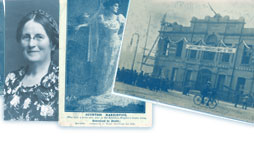

Easter Widows
When I first heard some of the stories of the 'Easter Widows' in the early 1990s, I could scarcely believe them: they sounded like fiction rather than fact. At first I was not sure this story could be written. Did the documentation survive? Was there enough first-hand material to tell it using the women's own words?
In 1994, I was told that Rónán, son of Áine Ceannt, had accidently burned all the family papers that he intended to bring to the National Library of Ireland (NLI). I believed the material was lost until, about twelve years later, a student brought my attention to a listing that had just appeared on the NLI's website. It was Collection List No. 97, compiled by Dr Brian Kirby, holder of the NLI studentship[] , in association with the National Committee for History, and was described as: 'a collection of the political and personal papers of Éamonn Ceannt, of his wife Áine and of her two sisters Lily and Kathleen O'Brennan.' This collection contained the letters and information to tell their story.

The Tom and Kathleen Clarke archive came up for sale in 2006. I was able to examine the entire archive before it was sold, as I wrote the overview essay for the Adams sale catalogue. I knew there had been some papers - Kathleen had said in her memoir that she just had her memory and the few documents that she had managed to preserve from military raids - but when the material came up for sale I was surprised by the extent of it, and particularly by the love letters between her and Tom. It gave me a real sense of discovery to be the first reader outside the family circle to be given access to them, albeit for the preparation of their sale. Looking at them before they got to an archive, to be reading them alongside Tom's prison letters, was a privilege. The love letters have been published, nearly in their entirety, in Gerard MacAtasney's Tom Clarke: Life, Liberty and Revolution, and are now preserved in the NLI. However, some of the supporting material is now dispersed for ever, as it was sold in different lots to private collectors and is therefore no longer in the public domain. The starting point for me, as for so many others, was Kathleen's memoir, Revolutionary Woman, published in 1991, edited by her grand-niece Helen Litton - a book which Helen aptly described as: 'the voice of Kathleen Daly Clarke - forthright, outspoken and passionate . . .' Re-reading this work alongside those letters gave me a completely different look at this period, and Kathleen's voice is a key part of this book.
Lillie Connolly's story was the easiest, because of the wealth of material written about their upbringing by her daughters Nora and Ina. The countless works on James himself, while invaluable, proved very difficult to condense into a 'romance' chapter. Retired Brigadier General James (Seamus) Connolly, Lillie's grandson, was so helpful with his family stories; even as I write this, I wish I could do more research following our recent conversations.
The holdings for Thomas and Muriel MacDonagh are substantial, and the NLI holds the first-hand material needed to tell their story, placed there by their descendants. These papers facilitated the writing of their story, alongside the literary biographies of Thomas MacDonagh, which gave a lot of biographical information on him.
The NLI was also a treasure house for Grace Gifford. Her love letters from Joe Plunkett are also among their holdings, as well as Grace's wonderful scrapbook, in which she records and corrects much of the misinformation about her wedding (debunking some of the stories and, alas, some of the famous song lyrics). Joe's grand-niece Honor O'Brolochain has done wonderful work on her grandmother's papers and, together with the use of the Plunkett family archive, was another key source for this book, as was Anne Clare's book Unlikely Rebels, based on Nellie Gifford Donnelly's papers.
Maud Gonne MacBride, John MacBride and their son Seán MacBride have all had biographies written about them. There are volumes of letters between Maud and W. B. Yeats, and also between Iseult and the poet; Anna MacBride White work both published and unpublished I have been so grateful to have been able to utilise here[BU3] . The Fred Allen papers in the NLI were a wonderful source for John's voice. I regret not being able to access Emory University's collection of Maud's papers on the divorce - but again the challenge was to keep their 'romance' chapter to a manageable length.
Over the years I met the children of these women - Dr Emmet Clarke, Maura Phillips and Joe Mallin, and so many of their grandchildren. I was given access to the Mallin papers, Agnes Mallin's diaries and Michael's love letters to her, which allowed their story to be told for the first time. I am very grateful for the trust placed in me by the Mallin and Phillips families.
Over time I was given access to precious family papers, photographs and personal recollections not to be found elsewhere. During those years they also gave me their friendship, they showed an interest in my family. Sadly, most of them have passed away over the past two decades without seeing my completed work.
It is unbelievable to me that Joe Mallin, the curly-haired toddler described in his father's last letter as 'my little man, my little man', the child of whom he wrote with anguish in his last hours 'I cannot keep the tears back when I think that he will rest in my arms no more', is the same person who has lived to read my words, my take on his story. People talk about living history - I have been fortunate enough to be able to have that experience. Thank you to all those descendants who let me do just that.



